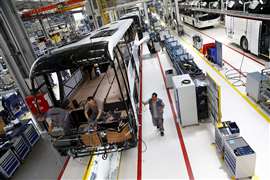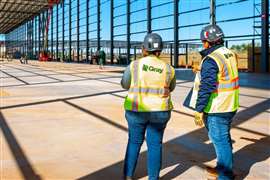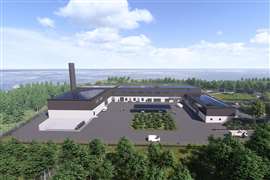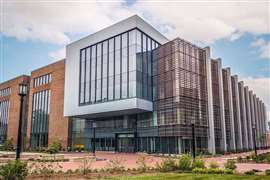Read this article in Français Deutsch Italiano Português Español
Defining ‘state-of-the-art’ on the manufacturing floor
19 January 2024
In this second installment of a three-part series on what makes a facility “state-of-the-art,” we examine a philosophy related to cutting-edge plant floor technology: smart manufacturing.
The term “state-of-the-art” is a difficult one to define. Typically, it’s meant to imply something that is the most technologically advanced. When describing a manufacturing plant, state-of-the-art can mean many things, such as designing for employee satisfaction and retention in today’s environment. On the plant floor itself, however, state-of-the-art often refers to the advanced technology and artificial intelligence that can help a manufacturer build products more efficiently, more safely and with higher quality.
Damon Sepe, North American OEM segment manager, heavy industry equipment for Rockwell Automation, used a particular term to describe “state-of-the-art” on the plant floor: smart manufacturing. It means using smart devices, machines and systems to autonomously monitor manufacturing situations, make real-time adjustments and continuously gather and analyze manufacturing data.
“The state-of-the-art facility needs to have smart equipment operating in it because you can’t have operators everywhere,” he said. “And for processes, there are all kinds of variables that, if the piece of equipment can change its process parameters based on real-time information it’s seeing, that also comes into play in smart manufacturing.”
Stem to Stern
 Employees work on the assembly line of the MAN bus production facility in Ankara, Turkey. (Photo: Reuters/Umit Bektas)
Employees work on the assembly line of the MAN bus production facility in Ankara, Turkey. (Photo: Reuters/Umit Bektas)
Sepe said smart manufacturing can apply to the entire manufacturing process, from the receiving dock to the shipping dock. “I have counterparts that deal with material handling systems, packaging equipment, process equipment and any type of high-speed assembly. They’re all talking about smart manufacturing. The context is a little different, and maybe as a solutions provider, the products we sell into it are different. But everything from the material handling systems as I mentioned to the process equipment to putting it in boxes and containers — however you’re packaging it — these conversations of smart manufacturing and secure operations are across the board.”
Questions to Ask
Given this broad scope, evaluating where and how smart manufacturing can be applied on the plant floor requires answering some key questions.
“A lot of times, we start those conversations around what is the problem — is there a problem or is there a bottleneck — what are we trying to solve or do better than what we’ve done in the past,” Sepe said. “And that can be framed even more broadly into what’s the desired business outcome. Do you need a plant that’s more efficient? Is it worker safety? Is it throughput? Is it energy usage that you’re trying to minimize? Once we understand what that problem area is or what is the desired business outcome to building this new facility, that’s where we’ll focus on what solution will offer as a solution provider.”
Determining ROI
As with all investments, investing in smart manufacturing, whether at a greenfield site or expansion of a current facility, comes with a price tag. Performing the right ROI calculations is important.
“Classically, when you’re looking at throughput, that calculation is pretty straightforward, right?” Sepe said. “More widgets per hour — there’s a return on that. Or looking at your electric bills and different variable costs. In today’s world, because we’re selling a service or selling at a solution to our smart manufacturing customers, it’s gone under a lot of different names, but a lot of times we’re helping them justify a large capital or operational expense to invest in a different solution.”
Rockwell conducts value workshops, Sepe said, to help customers understand the ROI of that expense. “We’ll facilitate the conversation with all the different disciplines within our customer and talk about what the problems are, and once we just decide what the solution will be, what value can we put on that and what will the ROI be.”
Sepe added that such value workshops might be two or three days long to allow for input from all the right organizational stakeholders, after which he and his colleagues will crunch the numbers regarding ROI.
Assembling the Team
 The amount of data produced by a smart manufacturing solution and the need to secure it requires the involvement of the IT department from the start. (Image: Zoonar GmbH/Alamy)
The amount of data produced by a smart manufacturing solution and the need to secure it requires the involvement of the IT department from the start. (Image: Zoonar GmbH/Alamy)
Regarding the stakeholders that must be included in the smart manufacturing discussion, Sepe said that it has always included operational functions, such as the plant manager, quality control personnel and logistics. There is one group, however, that is often overlooked but moving forward must always be included: IT.
“Both operations — OT — and the IT group need to be part of that discussion,” he said. “Because again, a lot of times, they’re two different functions, and one side of the house doesn’t always talk to the other. And it needs to be both entities.”
Sepe said that involving information technology is crucial given the data being produced and cybersecurity considerations. IT can also help manage hardware and software obsolescence.
“You know, as soon as you put a piece of equipment into a facility, the time clock starts going and things are getting outdated,” he said. “Firmware and software are revving all the time. And even Microsoft or whatever operating system you’re using, there are always patches coming down. A lot of times, if those two sides of the house — IT and OT — aren’t talking, the timing of when they do their patch updates can shut down production or create a vulnerability. None of those are good things.”
Keeping Data Secure
A benefit of the smart manufacturing approach is the wealth of data produced. This data could be used to further improve throughput and minimize waste. The sheer volume of data, however, coupled with the need to share it broadly throughout the organization — even to other locations — poses the aforementioned cybersecurity challenges.
“You’ve got all this data that’s proliferating, and some of it’s in equipment, some of it’s in the plant, some of it’s going outside the plant intentionally, but it needs to be secure,” Sepe said. “So cybersecurity is another area when we think about state-of-the-art.”
According to Sepe, implementing cybersecurity requires an understanding of who needs access to what information, who can change information and other variables and what the hierarchy within the organization needs to be. From there, it’s important to first take rudimentary cybersecurity steps, such as implementing appropriate password protection.
“And then you start talking about the equipment and the automation system that’s there,” Sepe said. “You can buy a switch at Best Buy, but is it a managed switch that has to have some kind of validation or authentication? If you’re going to go in and access it — access the information or change the setting — there are managed switches. So, the whole network architecture around how the data is moving from one device or piece of equipment into a SCADA system, or a supervisory control system — that whole approach the hardware and software architecture and the procedures that are in place all have to be accounted for.”
POWER SOURCING GUIDE
The trusted reference and buyer’s guide for 83 years
The original “desktop search engine,” guiding nearly 10,000 users in more than 90 countries it is the primary reference for specifications and details on all the components that go into engine systems.
Visit Now
STAY CONNECTED




Receive the information you need when you need it through our world-leading magazines, newsletters and daily briefings.
CONNECT WITH THE TEAM
















